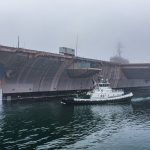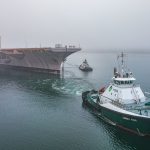The USS Kitty Hawk, the nation’s last oil-fired aircraft carrier, departed Bremerton on Saturday for a 16,000-mile journey around South America for its ultimate fate: scrapping at a Texas shipyard. Navy tug boats supported the ex-USS Kitty Hawk’s towing in its final transit from Naval Base Kitsap – Bremerton, Washington, to a ship-breaking facility in Brownsville, Texas. Kitty Hawk, the Navy’s last commissioned conventional-powered aircraft carrier, operated for 48 years before it was decommissioned in 2009. Like other Navy aircraft carriers since USS Langley’s commissioning 100 years ago, Kitty Hawk and the rest of our nation’s aircraft carriers and embarked carrier air wings have projected power, sustained sea control, bolstered deterrence, provided humanitarian assistance and disaster relief, and maintained our enduring commitments all over the world.
Onlookers, many of them former sailors aboard the “Battle Cat,” watched as tugs pulled the rugged warship into Sinclair Inlet on a foggy Saturday morning. At more than 1,000 feet long, the Kitty Hawk won’t fit in the Panama Canal, so the warship will be tugged through the Strait of Magellan en route to Brownsville, Texas.
USS Kitty Hawk was the lead ship of the Navy’s second class of “supercarriers” and the second ship in the Navy to bear the name. The first Kitty Hawk (ex-Seatrain New York), an aircraft transport (APV-1) (later aircraft supply ship AKV-1) (1941-1946), operated in the Pacific theater during World War II, playing a key logistics role in the timely buildup of defenses at Midway and Guadalcanal in 1942. Initially commissioned as attack aircraft carrier CVA 63, she was redesignated as multi-purpose aircraft carrier CV 63 on April 29, 1973.
Since August 1998, Kitty Hawk was homeported in Yokosuka, Japan, where she relieved the USS Indipence (CV 62) as the only forward-deployed aircraft carrier in the Navy. The Kitty Hawk left Japan for the last time in mid-2008. After participation in RIMPAC 2008, the carrier continued to San Diego, Calif., to meet the USS Geroge Washington (CVN 73) for turn-over.
The Kitty Hawk follows from Bremerton’s mothball fleet the USS Constellation, USS Independence, and USS Ranger, which were all dismantled at the same place: International Shipbreaking Ltd. The company contracted for the warship, along with fellow carrier USS John F. Kennedy, for the stately price of one cent.
“The contract values reflect that the contracted company will benefit from the subsequent sale of scrap steel, iron, and non-ferrous metal ores,” said Alan Baribeau, a spokesman for the Naval Sea Systems Command.































